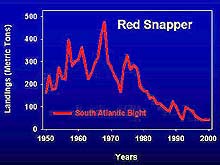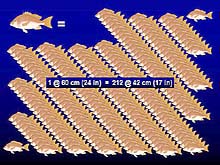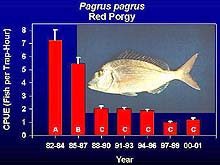
Increased demand for red snapper resulted in increased catches into the 1970s. Catches have since declined, as have fishery-independent estimates of abundance for most reef fishes. Click image for larger view.
Marine Protected Areas for Reef Fish
August 05, 2002
George Sedberry, Chief Scientist
Leg 1, IIS
Leg 1 of Islands in the Stream 2002 comes to an end today. Over the past nine days, we have explored suspected spawning sites and substantially added to our knowledge of important habitats for deepwater reef fish, especially those habitats that might be candidates for consideration under the protective management of marine protected areas (MPAs). However, our work is really just beginning. The samples and data we have collected will be taken back to shore so we may continue our analyses started at sea.
Appeal of Reef Fishes
Reef fishes such as snappers, groupers and porgies are in great demand as a source of food and for recreation. Many of these species are highly prized for their flavor and for the challenge in catching a large fish that lurks in rocky, treacherous bottom. The demand for seafood has increased enormously as human populations have increased, and as many people have discovered the health benefit in regular consumption of fish high in oils that are good for the heart.
Reef fishes, while appealing to the palate and desired by anglers, cannot support heavy fishing pressure, however. They grow slowly to a relatively old age (exceeding 40 years for some species), and mature late in life. Hence, it takes a long time to replace a fish removed from the population. Because of late maturity, many reef fishes reach a size that is large enough for consumption before they are mature enough to spawn and replace themselves. In addition, many reef fishes have complex social behavior and aggregate at specific, predictable times and locations to spawn. These spawning aggregations are often fished because they are predictable, and the fish are caught before they have a chance to spawn.

Large vs. small reef fish: Fishery management regulations such as minimum sizes allow fishermen to keep only the largest fish. As shown by the red snapper example, the largest fish produce the most eggs. One 24-inch red snapper produces the same number of eggs as 212 17-inch red snapper. So, by selectively removing the largest fish, the fishery removes the fish that have the greatest potential for producing more fish. Click image for larger view.
Federal and state fishery management agencies have implemented a variety of measures aimed at preventing overfishing of tropical and warm-water reef fishes, such as those found off the southeastern coast of the U.S. Using management techniques developed for short-lived, cold-water species, fishery managers have implemented minimum sizes for most species. Fish smaller than the minimum size must be released. For some species, there are “bag limits” whereby any fish caught exceeding a certain number (such as five groupers) must be released. Other fisheries have closed seasons. For example, the gag grouper fishery is closed during the prime spawning time for those species.
However, because of the combination of life history characteristics that reef fishes have, these management measures are not always effective. Minimum sizes result in selective catching of the largest, oldest and most mature fish, which produce the most eggs. So, the establishment of minimum sizes selectively removes those fish that have the greatest ability and potential to produce future generations of fish. In addition, the minimum sizes, bag limits and closed seasons result in incidental bycatch of the species, even if the angler is trying to avoid catching them.
Reef fishes exist in complex and diverse assemblages, with many species occupying the same limited reef habitat. Because so many species exist together on reefs, it is impossible to fish for a species or size that is allowed, without incidentally catching a species or size that is prohibited. Although the undersized fish or prohibited species can be released back into the water, many of those thrown back do not survive because of the trauma of being caught and brought to the surface. The deeper the reef, the greater and more frequent is the trauma. Moreover, if the trauma does not kill the fish, it often weakens it and makes it vulnerable to predatory fish like barracuda, large jacks, and sharks. So, regulations such as minimum sizes and closed seasons that require fish to be released do not always result in conserved fish. This is especially true on deep reefs (those deeper than 150 ft).

Research surveys indicate declines in abundance for most species of reef fish. Shown here is catch per unit of effort for red porgy. Click image for larger view.
The South Atlantic Fishery Management Council, which has jurisdiction in federal waters off the southeastern U.S., is considering establishing a series of MPAs to help restore stocks of deepwater groupers and snappers that have been overfished. The Council is considering the use of MPAs for deepwater reefs, where bycatch and release mortality of reef fish is high because of the diversity of species and the depth of the water. The Council will be holding public hearings prior to implementation of any MPAs. Those concerned about fishing and conservation, and who have knowledge about the deepwater reef fishes off the southeast coast, are urged to provide input to the Council.
MPAs are perceived by some to be an extreme burden on particular groups of fishermen. The consideration of MPAs as a fishery management by the Council has been preceded by much consideration and deliberation regarding the effect of closed fishing grounds. The Council is proceeding with caution, and is collecting data on the fishery and the ecosystem, so that MPAs can be located in areas for maximum positive effects, with minimum negative effects. All those involved generally concede that protection of spawning fishes is needed. To do this, it is necessary to pinpoint spawning locations and to describe spawning habitats.
One of our objectives for this expedition is to map and describe deep reefs that harbor valuable reef fishes in spawning conditions. The expedition participants are exploring sites where anatomical studies of fish have indicated that several species in spawning condition have been found at certain locations. Some of these locations coincide with areas proposed to the Council for consideration as MPAs. Before such consideration can proceed, we must map and describe suspected spawning locations, and to confirm spawning.
Sign up for the Ocean Explorer E-mail Update List.














































